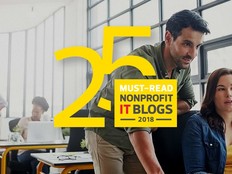4 Ways Nonprofits Can Harness the Power of Mobility
Mobile technology is no longer a nice thing to have for most nonprofits — it’s a must-have. Indeed, virtually every nonprofit organization has deployed mobile computing. Even at organizations that lack a centralized mobility strategy or significant investments in mobile technologies, staffers and volunteers are using smartphones and tablets to collaborate, communicate and interact with the organization.
Studies show that more than half of web traffic now comes from mobile devices, that mobile users are online for an average of three hours per day and that more than one-third of email subscribers only read emails on their mobile devices. Given these numbers, nonprofits that don’t plan for mobility are putting themselves at a tremendous disadvantage. If, for example, 35 percent of donors are reading fundraising emails on their phones, but messages are written with 15-inch computer screens in mind, an organization might be missing out on donations and engagement from those mobile users.
By deliberately adopting a well-considered mobility strategy, nonprofits can enhance staff productivity, improve service to clients and optimize outreach to donors.
When crafting an overall mobility strategy, it’s important for nonprofit IT leaders to consider specific use cases and business benefits of mobile technologies. These will vary by organizational size, structure and mission, and may include the following. Here are four ways nonprofits can make use of mobile technology.
SIGN UP: Get more news from the BizTech newsletter in your inbox every two weeks!
1. Keep Field Volunteers Connected
Nonprofit organizations don’t exist to create the best possible offices and workplaces; their missions take employees and volunteers out into local neighborhoods and far-flung regions to solve problems in the real world.
Mobile devices support community service by keeping volunteers in touch with the organization, helping them coordinate efforts on the ground and allowing them to document conditions and file reports.
Mobile apps can help nonprofits track volunteer hours; check people in at large volunteering events; and recruit, schedule and engage volunteers. Tablets and mobile kiosks have helped organizations to eliminate the confusion and mess of paper signup sheets, whiteboards and Excel spreadsheets, improving accuracy of records and reducing wasted materials and staff time.
2. Boost Nonprofit Staff Mobility and Productivity
A number of nonprofits allow employees to work remotely, which can cut costs, improve job satisfaction and support sustainability goals.
According to the “2017 State of Telecommuting in the U.S. Employee Workforce” report from Global Workplace Analytics, telecommuting has grown by 115 percent over the past decade, with employers saving more than $11,000 per half-time telecommuter each year. Still, only 7 percent of employers make telecommuting an option for most employees, and nonprofits lag behind for-profit businesses in this area. Mobile technologies can also increase productivity for office-based staff, allowing them to stay in touch and continue to work while they’re on the road.
3. Enable Effective Disaster Response
For organizations performing work in areas hit by natural disasters, mobility keeps people connected and supports ground operations. While mobile networks are sometimes knocked out by severe storms and earthquakes, cellular service is often among the first utilities to be restored in the aftermath of a disaster, giving nonprofits the ability to communicate with people outside the disaster zone and coordinate relief efforts.
After a disaster, mobile devices may be the only means by which affected residents can get online; therefore, it is important for nonprofits serving these populations to ensure online resources are mobile-friendly.
4. Make Mobile Fundraising a Breeze
While nonprofits are continuously looking for new and better ways to prompt donors to open their checkbooks, people are changing the way they give (and younger donors may not even have a checkbook). According to The Chronicle of Philanthropy, the share of donors who give via their mobile devices grew by 80 percent between 2013 and 2016. Nonprofit organizations that don’t provide people with opportunities to make donations using their mobile devices (by texting donations, for example) are missing out on increased donations and even new donors.
Mobile point-of-sale solutions can also help nonprofits to raise money at events where a large number of existing and prospective donors are gathered. Rather than asking people to pledge donations, which can be time-consuming and cumbersome to collect at a later date, nonprofits can ask donors to simply swipe their credit cards on an mPOS-enabled device.
With the right apps and data management practices, nonprofits can also use these interactions as an opportunity to collect or confirm information such as email addresses, mailing addresses and phone numbers.
Learn more about how mobile solutions can help nonprofits by downloading the white paper "Using Technology for Good."








